Tags
6 Ideas – 6 Tasks
Eternal Punishment: This is not generally known, but in Dante’s ‘Inferno’ there is a special place for teachers who have led a sinful life; it is a classroom where they are condemned to teach Mixed Ability Classes (MAC) for all eternity. As this is somewhere between the 8th and 9th level, that gives one some idea of how most colleagues feel about having to teach such groups… 🙂
The problem – and 6 solutions: A lot of fine distinctions are made about what we mean by ‘Mixed Ability’ but for most teachers what matters is the difference in level. This can be a huge headache for teachers; if the material or task chosen is too hard, weak students may not be able to follow; if it is too easy, the strong students will finish early and have nothing to do. To deal with this problem I would like to look at 6 simple ideas and 6 practical activities which I have found immensely helpful with my students.
[NB: This article is based on a presentation I gave some time ago. To see/download the slides, just click here]
We can give students different tasks: There is no reason why all students should have to do the same thing. One solution would be to use the same reading or listening text for instance, but give the stronger students a more challenging task.
Task 1 – Same text, different task: A quick look through a text or the transcript of a dialogue / listening task should give us an idea of what we can ask our students to do. The idea is simple: we can ask the weak students to do something simple, and the strong ones to do that plus something else. For instance (depending on the text) we could perhaps ask weak students to write down the names of the people talking and the strong ones to write down their names and nationalities. In the case of this listening activity (click here to listen to the track), we could ask the weak students to write down the numbers they hear and the strong ones to write down the numbers and what they refer to.

We can give students self-adjusting activities: Another idea would be to give students activities which are ‘self-adjusting’. This means that they can be performed by students at different levels of linguistic competence; the main task can be performed by everyone – it is the level of sophistication of the language that changes.
Task 2 – A story and 3 lies: Students work in pairs. Student 1 thinks of a true story about him/herself. Then s/he tells this story to Student 2, but they have to include 3 lies in their narrative. Student 2 has to listen carefully and try to identify the lies. Then they swap roles (NB: To ensure there is no cheating, before the first student starts talking, s/he makes a note of the 3 lies on a piece of paper so s/he can show them to his/her partner afterwards). Here is a short demo (click here to listen to the story). Can you spot the 3 lies? *
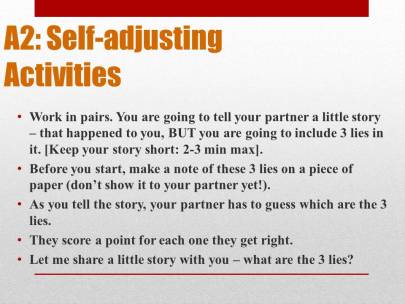
We can use collaborative tasks: In this case a strong and a weak student have to perform a task together. Each of them has some kind of information to contribute, but naturally, for the stronger student to convey his/her information, they require higher linguistic skills.
Task 3 – Spot the differences: In this task, the weak student is given a passage describing a picture in some detail; the stronger student is given the picture itself (see the slides below). There are some differences between the description and the actual picture. The two students have to memorise their information (the passage and the picture respectively) and then they take it in turns to share it with their partner as best they can. They have to do so without looking at their picture / text. Then they work together to discover all the differences (again without looking at the passage or the picture).
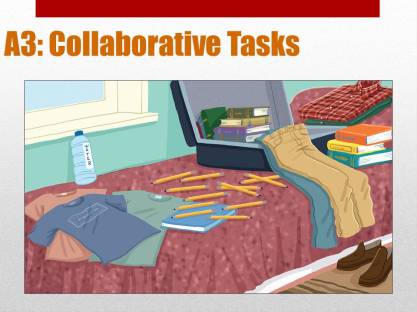
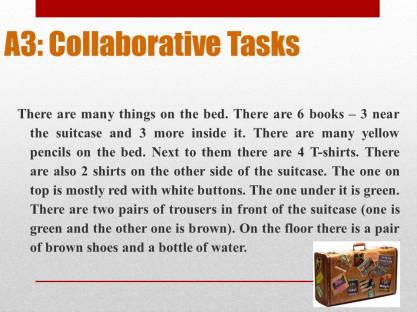
We can give students different roles: Here once again we pair up a strong student with a weak student, but their roles are different. In the task below, the weaker student’s role is linguistically easier but it is actually more important than that of his/her partner.
Task 4 – Running dictation: The teacher puts up a short text on the board with blue-tac (it’s best to put up many copies, so that students do not jostle each other). On the teacher’s signal, the weaker student in each pair runs up to the board and tries to memorise as much of the text as s/he can; then s/he runs back and tell his/her partner what to write; then s/he runs back to the board for more, etc. The first pair to finish are the winners (but the teacher needs to check that they’ve got the spelling right!).
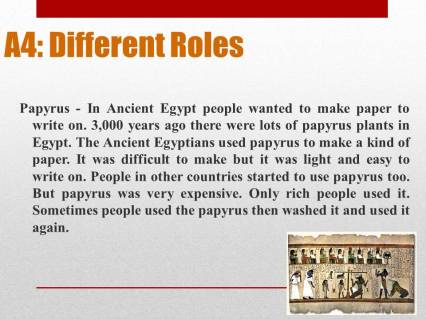
We can set a low threshold level: In this case we give the whole class the same, open-ended task. By setting a deliberately low level we can ensure that weaker students can feel they have done well, while stronger students can go on and do better.
Task 5 – ‘At least….’: The key phrase here is ‘at least’. For instance, if it is a vocabulary revision activity, you can tell students ‘Write down at least 5 means of transport’. If it is a reading text, the task can be something like ‘Find at least 4 reasons why the writer thinks zoos are a bad idea’. In a cloze passage it can be ‘You have to fill in at least 8 out of the 20 gaps’ or (as is the case in this revision task) ‘Answer at least 20 questions’. (Click here to see a sample vocabulary quiz).
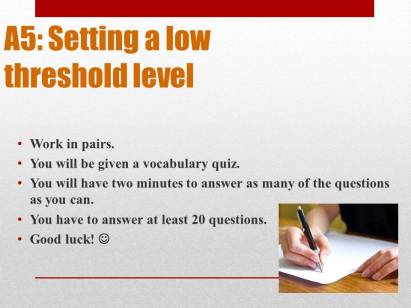
Pitching the task at different levels: In this last activity (one of my favourites) again we have a stronger student paired up with a weaker one. Their task is the same, but the level of difficulty is higher for the stronger student.
Task 6 – Hide the word: Each student is given a list of words, but those of the strong students are more difficult. Students speak in turns. Student A writes one of his/her words on a slip of paper. Then s/he has to speak for 30 seconds and s/he has to use this word at least once. (In fact s/he has to try to ‘conceal’ the word s/he has chosen in what s/he says). The other student makes a note of all the ‘suspicious-sounding’ words their partner uses and then tries to guess the ‘hidden word’. S/he has 3 guesses. If s/he guesses right at the first go, s/he scores 3 point – or two or one if they are unsuccessful initially. Here is a short demo. Which is the word I have tried to hide? **
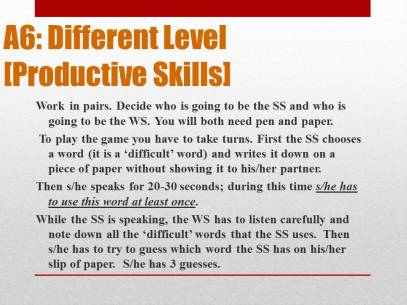
The classroom as a lift: Undoubtedly mixed ability classes are a challenge but of course this is rarely the teacher’s fault – we just need to do our job as best we can. I remember reading a metaphor somewhere about seeing the classroom as a lift; everybody gets in but it does not matter if people get off on different floors; what does matter is that the lift goes up! 🙂

[ * The 3 lies: Andrew was not dyslexic / Andrew liked a sitcom (‘Friends’) not documentaries / Andrew was moved to a higher stream; his marks were not changed. ]
[ ** The word I tried to hide was ‘Billboards’. ]
![Psychology for Educators [And More] Psychology for Educators [And More]](https://s0.wp.com/wp-content/themes/pub/chateau/images/chateau-default.jpg)